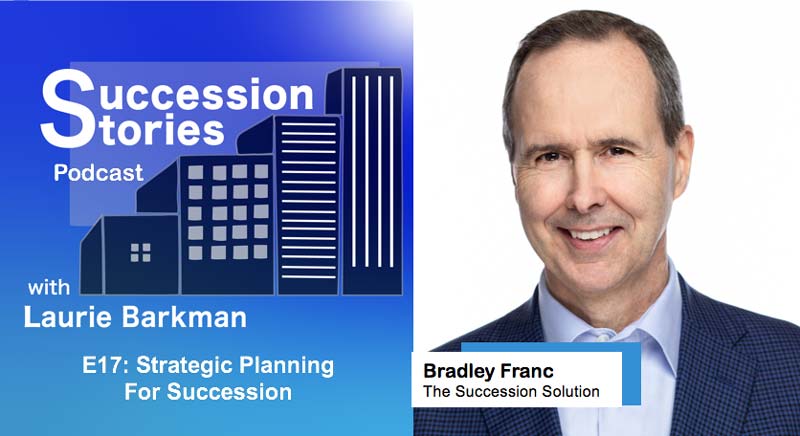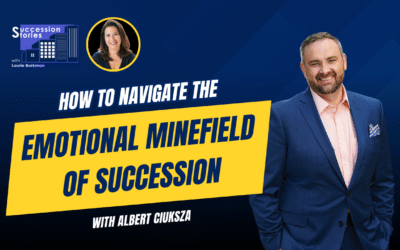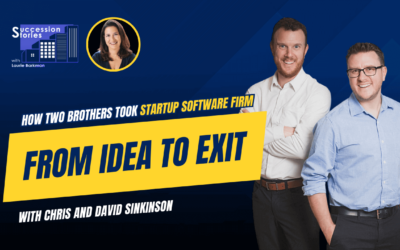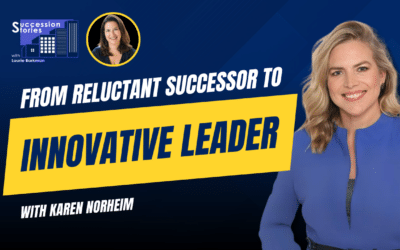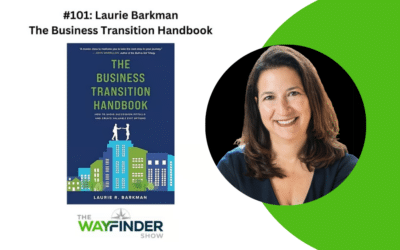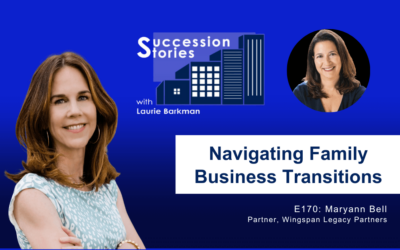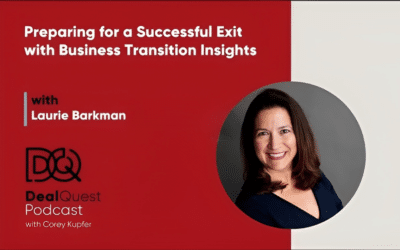Listen to the episode:
On the Season 1 Finale, Bradley Franc, author of The Succession Solution, joins Laurie Barkman to discuss how business owners can bring the future into the present by including transition planning as part of strategic planning. Listen in as they discuss Bradley’s framework to identify obstacles and develop a roadmap forward. Bradley also shares succession stories where obstacles broke up the company and the family.
Subscribe to the podcast:
You can subscribe to the Succession Stories Podcast on Apple Podcasts, Google Podcasts, Spotify, Stitcher, or our podcast page.
If you enjoy the episode, please give a 5-star rating and review in Apple Podcasts or your favorite streaming platform to help others find the content.
Show links:
- Bradley Franc Bio
- The Succession Solution Website
- The Succession Solution Book on Amazon
Full transcript:
Laurie Barkman:
Welcome to Succession Stories, insights for next generation entrepreneurs. I’m Laurie Barkman. I’ve spent my career bringing an entrepreneurial approach to mature companies struggling with change as an outside executive of a third generation, 120 year old company, I was part of a long-term succession plan. Now I work with entrepreneurs, privately held companies, and family businesses to develop innovations that create enterprise value and transition plans to achieve their long-term goals. On this podcast, listen in as I talk with entrepreneurs who are driving innovation and culture change. I speak with owners who successfully transitioned their company and others who experienced disappointment along the way. Guests also include experts in multi-generational businesses and entrepreneurship. If you are a next generation entrepreneur looking for inspiration to grow and thrive, or an owner who can’t figure out the best way to transition their closely held company, this podcast is for you.
Laurie Barkman (00:58)
I’m excited to introduce this episode as the Season One Finale. Succession Stories will be on a short break returning soonish on September 15th. It’s been fantastic getting the show off the ground with 17 amazing guests.
Next season, I have some new things planned including a Q&A episode. You’re the customer and I want to address topics that you care about. If you have any questions about innovation, succession, or next generation growth strategies, message me on LinkedIn or via email at successionstoriespodcast@gmail.com
Laurie Barkman (01:34)
I was excited to talk with Brad Franc because our discussion was about the intersection of succession planning and strategic planning. In my experience, strategic planning has been a powerful tool for identifying obstacles and developing a roadmap forward. Brad talked about the planning framework from his book, The Succession Solution, and the phases to make it actionable. Identifying the obstacles to succession is a big part of the work, but some obstacles are not solvable. He shared some succession stories where greed broke up the business and the family. I think you’ll enjoy our conversation. Thanks for tuning in!
Laurie Barkman (02:05):
Brad, welcome, I’m excited to be with you today on Succession Stories. You’re so accomplished. You’ve written a book called The Succession Solution. It’s a program that works with closely held companies and their transition to the next generation. You’re also an entrepreneur, you’ve created four different companies. If that’s not enough, you’re also an accomplished lawyer, a former CPA, and you have 30 years of experience representing closely held businesses in succession planning. So we have a lot to talk about. I know you’ve probably seen it all when it comes to succession, the good, the bad, and the ugly. Most companies fail in the transition from generation to generation with only about 15% making it to the third generation, or G3. I wanted to start by talking about your family and your family’s experience. I saw on your website, The Succession Solution, that you share your family’s history with its business that didn’t make it to the third generation. So I thought that would be an interesting place to start. Let’s start with your family’s succession story.
Brad Franc (03:16):
Thanks, Laurie. It’s a pleasure to be here, first. And it is an interesting story. Back in the late 19th century Francisco Sanguigni sells everything that he has in Pisa, Italy, and comes to the United States and lands in Pittsburgh, Pennsylvania. He starts a macaroni and bread company. He has a young son named Alexander who’s nine years old, grows up in the business, buys a truck to deliver bread and macaroni. And like most of us who know friends who have trucks, everybody wants help with their truck hauling stuff. So he starts a hauling company. Alexander Sanguigni starts and develops a tremendous construction company in Western Pennsylvania, working on some of the biggest projects. Unexpectedly, he passes away at age 59 with nine children and a wife who doesn’t know what to do with the business. The construction business is a very relationship oriented business.
Brad Franc (04:18):
She doesn’t know what to do. So she has an auction with her children and sells it to one of her children. My grandfather at the time was overseas fighting in World War II, couldn’t come back. His brother takes the business over, and quadruples the size of the business. He does developments in the Golden Triangle, a number of large projects in Pittsburgh, Three Rivers Stadium, moving all sorts of dirt. And he passes away, once again, unexpectedly at 59. Once again he does no planning and leaves it to two sons and they couldn’t get along. The one son leaves, the other son tries to buy his brother out. He refuses and what my uncle tells me, when I was writing this book, he says, “I wasn’t going to work and give half the profits to my brother. So I shut everything down.” And as you indicated, the third generation failed to make it. And that was the end. And it was a very successful company and employed lots of people, but basically two brothers couldn’t get along.
Laurie Barkman (05:27):
Did it separate the family forever? Were there two sides at that point? You were either in one camp or the other?
Brad Franc (05:34):
You got it. They wouldn’t talk to each other for decades. Eventually they ultimately reconciled, but there was still a degree of bad blood, which is unfortunate, but it did. It was a very emotional time and it’s not much different than many of the other stories I’ve seen.
Laurie Barkman (05:51):
Yeah. There’s so much emotion with all of that. It sounds maybe that the predominant emotion was anger.
Brad Franc (05:58):
Well, I love my family. I think a little bit was greed. You can never have enough in some people’s minds. And it’s unfortunate because half of something is better than 100% of nothing.
Laurie Barkman (06:10):
Right. And so that influenced you. You grew up hearing about that story and you have this really unique skillset because you have a law degree. You’ve been practicing law for about 30 years, you’re a very accomplished attorney. You’ve been a CPA and you are accomplished in business planning. That’s a very interesting combination. And I also see that you have this entrepreneurial gene from your family. So what prompted you to go in that direction where you went to law school, but then you started different companies outside of the law firm.
Brad Franc (06:42):
Yeah, I think Laurie, I have always been an entrepreneur from the day that I had my own paper route. But what happened when I was early in my legal career, I’d like to say it was my idea, but a friend of mine came to me and said, what do you think about this idea? And it intrigued me. And we started the business. We lost money in the first year. We broke even the second year. We questioned whether we were crazy, but we made it through and found success and ultimately sold that company to a publicly held company. And at the same time, there was another opportunity that presented to ourselves. And we took advantage of that.
It’s like anything else, as the saying goes, you walk down a hallway and doors open up. If you don’t start walking down that hallway, you’re not going to see the door to walk through. And so we started down that entrepreneurial journey.
Laurie Barkman (07:35):
So last year you wrote a book called The Succession Solution and it’s a culmination of many things in your career. What inspired you to write it?
Brad Franc (07:43):
Yeah, that’s a great question. I think there are a few inspirations, but as I mentioned in the book, a number of years ago, I was at NYU Tax Institute with all of the brightest and best tax lawyers. And there was a woman partner who stood up and talked about succession planning and the failure rates. And she said, you know whose fault it is? And she pointed the finger to the crowd of a bunch of CPAs and lawyers. It’s your fault. You don’t educate your clients about succession planning. And so that sort of started me on my journey.
The other reason I wrote it was over 30 years of seeing so many businesses – although each one is different – there are so many similarities, foundational issues with respect to succession planning. And I thought if I could put that in writing and develop a process it could help those people.
The last reason was I wanted to prove it to myself. They say writing is the highest form of thinking. For four years, I sat down and wrote this thing out to prove it to myself.
Laurie Barkman (08:48)
Did you say four years?
Brad Franc (08:49)
That was a lot of weekends.
Laurie Barkman (08:51):
A lot of weekends. Yeah, because at this time you are working full time with the law firm. You are also serving clients outside of that with one of your other businesses. And so did your family think you were crazy?
Brad Franc (09:04):
Yes, they did. Some people bowl every Thursday night or play tennis, and I write. It’s very painful, it’s difficult, but it’s very rewarding once it’s done.
Laurie Barkman (09:17):
I liked your book. I think it’s very clear. As someone who’s a practitioner of strategic planning, I thought it had a really great parallel to business language. You’re not writing it as a lawyer. You’re writing it as a business practitioner. I think it’s coming in this interesting intersection between succession planning and strategic planning, and you use some of the frameworks that are best practices. And I thought that was really great. If you want to talk now about the process, I think that would be helpful. I’d like you to talk about the stages of succession. In your book, you referenced six of them. So maybe at a high level, if you could talk about that, and I’m really interested in your perspective on which stages tend to be the most challenging for family businesses and why.
Brad Franc (10:04):
I’m glad you brought up the intersection of succession planning and strategic planning, because I believe that succession planning is strategic planning. It has to be part of your strategic plan because succession planning really is bringing the future into the present.
And so when I worked with all these closely held business owners and they struggled with succession planning, it was because they got comments and recommendations from all very, very bright professionals, but they had no way of consolidating and looking at it in a global, one picture kind of framework. So what happens is the CPA says something, the lawyer says something, the insurance person says something, the consultant says something. What does a business owner do? He goes into shutdown. What I did was I developed a framework that I believe addresses and captures, I don’t want to say a 100%, but pretty much 90%, of what I think a business owner needs to think about from a succession planning standpoint.
Brad Franc (11:12):
There’s six stages and I’ll go through them at a very high level. So I use these terms, these are my terms. There’s nothing magical about them. The first stage is the Purpose Stage. Why are we doing this? Simon Sinek, the author of Start With Why, states that if you can describe the why, you can have the strength to get through it. So the Purpose Stage is starting with the fundamental principles and values of the company, why we want to do this, and what’s our ultimate vision. It’s our North Star. That’s kind of the purpose stage– why. The next stage is the Discovery Stage. I can’t tell you how many business owners don’t remember or know what type of plan they have in place, or no plan. Even no plan is a plan. And so what you want to do is discover where you are. The analogy I give is when I go into Ross Park Mall in the North Hills, and I don’t know where a store is, what do I do?
Brad Franc (12:08):
I go to the big kiosk, and look for the red dot. Where am I? You gotta know where you are if you want to get to someplace because you need to go left or right. So that’s kind of the Discovery Stage. The third stage, I think is probably the most important in my opinion. And I call it the Challenge Stage. And it’s nothing more than a SWOT analysis if you’ve done strategic planning, but mine’s a little different. So you identify the strengths. Those are those things you’re going to rely on to help you with succession. The opportunities, if we get this right, what good things will come from it? But most importantly, the obstacles. Ryan Holiday wrote a great book, The Obstacle Is The Way.
I believe if you sum this thing up very simply, if you know where you are, and you know where you want to get to, the only thing that’s stopping you are the obstacles, otherwise you’d be there.
Brad Franc (13:03):
Once you identify the strengths, the opportunities, then I start the Mission Stage and we look three years out.
Bill Gates once said, “Most people overestimate what they can do in a year. They underestimate what they can do in five.”
So if you ask a business owner to do something in the next 90 days, he’s going to be freaked out or she’s going to be freaked out. I can’t do it! I got too many things! But if you say Laurie, we’re sitting here three years from today, what would you like to see have happen? It’s a little easier. And then you say, okay, Laurie, we identified these obstacles. One of the things we can do of the next three years to overcome them. And then we list that. And the next one, we just bring it forward to a year. Okay? If this is what we want to do in three years, what do we want to do in one year?
Brad Franc (13:52):
Once again, we go through the same process. Then lastly, we say, okay, this is what we want to do in the next 12 months. What do we need to do in the next 90 days to make sure that we are moving forward and we’re not trying to boil the ocean. We’re just taking these small steps. And it is incredible how many times we accomplish what we want to accomplish in a year in six to nine months, and not 12 months. The area that I find people get the most energy from, and at the same time, struggle is one. The first thing we do is we identify the core principles or values of the company because there will be struggle. There will be debate and there will be arguments. And when you go back to ground zero to say, are these, do they reconcile to our principles and values? The decision making becomes a little easier. So establishing those are really important. And then the obstacles, what’s preventing, because that’s really hard. Mom won’t let go. Dad won’t let go. Well until we get that out on the table, we’re not making progress. So that’s it, kind of in a nutshell.
Laurie Barkman (15:05):
Yeah. That makes a lot of sense to me, especially from the strategic planning standpoint, because those are the core elements from a business standpoint. If you have a vision or a plan to grow, you have to start with what are your values? What is your core vision? What is the mission? And aligning all those people in the room. Who typically is in the room? Is it just family? Is it some advisors? In your experience, who’s in there?
Brad Franc (15:32):
Yeah. That’s a great question. And there’s no perfect answer. Each situation is unique. But I would prefer to err on the side of more, not less. You want to try to identify the important stakeholders in the room. You can start with one, two, or three, and then add people as you progress and develop your plan. It only takes one or two important stakeholders to try to create a problem with your plan if they don’t like it. But if you engage them, give them a little oxygen. You don’t have to agree with them, but at least as long as they are heard, there’s more of a chance of success with adoption. Typically it would be the important family members, the important stakeholders, the key employees, because they have a stake in it, but they can also talk in a more dispassionate unemotional manner if you’re dealing with family members. Having that advisor in there is not bad. It’s easy for me to say this, a facilitator really helps the process. Do you absolutely need one? No, but I found that when you have one it works a little better.
Laurie Barkman (16:42):
Yeah. You’re independent, you can ask good questions, you can challenge thinking. You can certainly document as things go. So the facilitator can play a pretty important role. Is it the third stage, the Challenge Stage where you have the most aha moments because it is full of friction? You’re trying to draw out all these issues, right? That’s the stage, that’s its purpose. Is that where also the light bulbs go off too?
Brad Franc (17:06):
It does because people start to reveal themselves. All progress starts with honesty. Until we have an honest discussion, whether “I don’t have enough money to retire.” Or, “I can’t stand the CEO, I don’t want to work with her anymore.” That’s going to be an obstacle. But yes, that’s when the rubber hits the road.
I would suggest identifying the obstacles is probably more important than trying to resolve the actions to overcome the obstacles. Because once you get it out there, I think you’ve made 80% of the progress in accomplishing.
Laurie Barkman (17:51):
Yeah, that’s been my experience too, identifying the obstacles so you can deal with them appropriately. And as you were saying earlier, it might be that they’re accomplished in six to nine months, or it does take longer. But the key is identification, documenting, and then assigning the work so it gets done and holding people accountable. How do you do that? Do you come back together? So there’s these sessions I’m imagining, and then is there a process that kind of takes people through over a period of time?
Brad Franc (18:17):
That’s absolutely correct. It was a rather big project. I was engaged in the Philadelphia area and the guy said, well, we could do this in one day, right? And I said, no. And as a matter of fact, don’t engage me unless you’re willing to meet with me four times throughout the year. Every 90 days we meet because you can have the greatest, as I’m sure you’ve seen Laurie, you can have the greatest strategic plan with all the bells and whistles and graphs and flow charts. Yet nothing gets done unless you execute. And you’ve got to keep people accountable. Now, what’s that saying? If you want to improve something, measure it. If you want to improve something exponentially, measure it, and report on it.
Laurie Barkman (19:02):
That’s true measure and report on it. My former CFO used to say, plan your work and work your plan. And part of that is like you said. But then the other part is, yeah, you have to meet on it and hold people accountable. Don’t just create a pretty binder that sits on the shelf, collecting dust. Nobody cares about that. It needs to be actionable and it needs to move forward. So I liked the process a lot. I was curious about the stories. Are there any transition success stories that stand out to you and what made them successful?
Brad Franc (19:32):
Yeah. Sometimes the most interesting ones are the scariest ones. So two years ago I was engaged by a closely held business owner, a very successful second generation. And, he owned 51% of the company. And the key employee owned 49% of the company that his father, that the first generation had given this key employee, 49%. And the 51% owner family member was frustrated because the company kept growing in value and he knew someday had to buy him. And the employee who had 49% was concerned because he wasn’t in control, and didn’t see eye to eye, but needed some way to retire. And they had hired a key executive in the industry who was a first round draft pick- a superstar. And they wanted to promote him to be the President and he refused. He wouldn’t take the job. And he said, “Until you two figure out what you guys want to do, I’m not signing up and I’m thinking about leaving.”
Brad Franc (20:43):
We sat down in the first meeting, the soon to be President looked at me and says, “I don’t know what you’re going to do. These two can’t get along. And I have no faith in these guys. Cause all they do is talk.” And after, we sat down and established the values and we knew what the obstacles were. At the end of the year, the 49% owner was very happy because he found a number that he was satisfied with. They gave him a long runway to work for five years as the COO. The key employee saw that these guys had a plan. He agreed to become President. And the 51% owner agreed to a purchase price, which probably was a little more than he originally wanted, but he was happy. And these guys were really shocked because if they were asked at the beginning of the year, they would never sort it out.
Laurie Barkman (21:38):
So there’s a lot of talking happening. It was frustrating. The President said, I’m out if you can’t figure this out. And so you played a really critical role there. Did it feel like just that things were not going to move forward, or you inherently knew that you could work it out with them?
Brad Franc (21:54):
No, actually the day, we meet quarterly as I said. At the second quarterly meeting, the 49% owner was supposed to do some homework and he hadn’t. The 51% owner said, “That’s it, I’m done. I am not going to have this meeting if this is the attitude they’re going to take.” I said, look just be patient. Let’s sit down, let’s hear it out and let’s move forward. And so part of my job is to remove the emotion. What happened was, guess what…the 49% owner, he came with the information. He was supposed to send it out, but he was being a little cute about it. And you know, all of a sudden, a lot of tension left when we started making some progress. One of my mottos is “Don’t make matters worse.” I think that’s the value of a facilitator is I didn’t have all the baggage. So that was a good story.
Laurie Barkman (22:47):
Yeah. That is a good story. Now what about when things don’t work out as planned, despite the best efforts. Can you share any stories of situations where there was a turn for the worst and you just couldn’t bring it back?
Brad Franc (23:00):
Yes. I had a situation where a gentleman had passed away. The business owner had passed away. He had pretty successful business and he divided it three ways between his three children, and gave one child a controlling interest. And the one child was a little bit of an ogre and he took advantage of his siblings. We tried to resolve it but there was so much bad blood that she had engaged legal counsel in a lawsuit and sued. There was no way of bringing it back as hard as we had tried. The damage had been done. That was a situation that was two decades ago where we tried to help. Sometimes you just can’t undo some stuff that family members do to one another.
Laurie Barkman (23:51):
Sometimes when you bring the lawyers in, it gets tough, right. And that makes Christmas dinners difficult.
Brad Franc (23:56):
They don’t talk to each other.
Laurie Barkman (23:58):
Yeah. That’s a tough one. It’s hard to recover from that. So as the next generation assumes the seat at the table in whatever form…if the next generation is a third party, if it’s a management buyout through an ESOP, if it’s truly a family next generation, what advice do you have for the incoming and outgoing family members?
Brad Franc (24:20):
That’s a really important aspect because they are as critical as the prior generation, Laurie. A couple of things. I think Ross Perot once said:
“Be grateful for what you have, but not satisfied from where you are.”
So with respect to the next generation is be grateful that somebody, whether it was a non- family member, it’s an ESOP, or passing on to the next generation, that this business has been established but not satisfied. And the other part I would tell the next generation is to educate so that they are better prepared to have those conversations, those hard conversations, as to why this is important. Next week, I’m meeting with the young YPO’ers. These are children of business owners involved in this organization. And I give them a lot of credit. There will be seven of them and they are in their twenties trying to learn about succession planning. I would suggest to you that if the Sanguignis in my family, in their twenties, talked about succession planning, they may have avoided some of the fighting.
Laurie Barkman (25:31):
So thank you. Last question, I like to ask all my guests, what’s your favorite saying or mantra regarding entrepreneurship?
Brad Franc (25:39):
Well, there’s, there’s a ton of them, but there’s a book I read last year called Legacy. And it’s about the All Blacks, which is the most successful sports franchise, I think, in the world. And there’s a line that says:
“A plan without action is nothing but a dream. Action without a plan is nothing but a nightmare.”
And that’s what The Succession Solution is. It’s a plan with execution.
Laurie Barkman (26:06):
That’s a great quote. So that’s a wonderful place to wrap up. Brad, thank you so much for being with me today. And it was a pleasure talking to you.
Brad Franc (26:13):
Well, the pleasure was mine. Thank you very much.
Laurie Barkman (26:15):
Thanks for listening. I hope you enjoyed the episode. Three things before you go:
1. Follow Succession Stories Podcast on LinkedIn. Join the community to share feedback, submit questions, and ideas for future episodes.
2. If you want to develop a roadmap for your business to innovate, transition, or grow, let’s talk.
3. Hit 5-stars in Apple Podcasts and share with friends on GoodPods if you enjoyed the episode.
Thanks again for tuning in!

